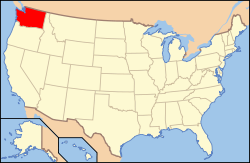

The following outline is provided as an overview of and topical guide to infrastructure of the U.S. state of Washington.
Contents
- By era
- Mid 19th century
- Late 19th century
- 20th century
- 21st century
- By topic
- General
- Communication and computing
- Energy
- Environmental and scientific
- Military complexes
- Transportation
- Water management
- By type
- Bridges
- Dams
- Pipelines
- Roads
- Tunnels
- Highways
- Railroads
- Passenger train service
- Mass transit
- See also
- Footnotes
- References



